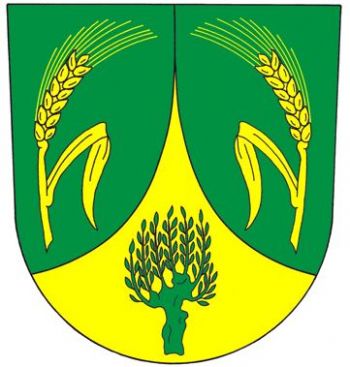Großziethen: Difference between revisions
Jump to navigation
Jump to search
Knorrepoes (talk | contribs) m (Text replacement - "Literature :" to "'''Literature''':") |
Knorrepoes (talk | contribs) m (Text replacement - "{{media}}" to " {{de1}} {{media1}}") |
||
| Line 24: | Line 24: | ||
The golden point is taken from the compass in the arms of Schönefeld and also refers to the fact that the former municipality forms a point into the area of Berlin. Historically the area was rural and agricultiral. This is shown by the green field, the willow tree and the wheat ears. The golden point refers to the sandy soils. The two wheatears also refer to the two villages in the former municipality. | The golden point is taken from the compass in the arms of Schönefeld and also refers to the fact that the former municipality forms a point into the area of Berlin. Historically the area was rural and agricultiral. This is shown by the green field, the willow tree and the wheat ears. The golden point refers to the sandy soils. The two wheatears also refer to the two villages in the former municipality. | ||
{{ | |||
{{de1}} | |||
{{media1}} | |||
[[Civic Heraldry Literature - Germany|'''Literature''']]: MOZ | [[Civic Heraldry Literature - Germany|'''Literature''']]: MOZ | ||
Revision as of 11:52, 26 December 2022
This page is part of the German heraldry portal Deutsche Wappensammlung |
Heraldry of the World |
|
German heraldry:
|
Selected collector's items from Germany:
|
GROSSZIETHEN
State : Brandenburg
District (Kreis) : Dahme-Spreewald
Incorporated into : 2003 Schönefeld
| German | In Grün, gespalten durch eine eingebogene goldene Spitze, vorne und hinten je eine zur Spaltungslinie geneigte begrannte goldene Ähre, unten eine grüne Kopfweide. |
| English | No blazon/translation known. Please click here to send your (heraldic !) blazon or translation |
Origin/meaning
The arms were not used by the municipality, but designed after the merger in 2003.
The golden point is taken from the compass in the arms of Schönefeld and also refers to the fact that the former municipality forms a point into the area of Berlin. Historically the area was rural and agricultiral. This is shown by the green field, the willow tree and the wheat ears. The golden point refers to the sandy soils. The two wheatears also refer to the two villages in the former municipality.
Literature: MOZ


